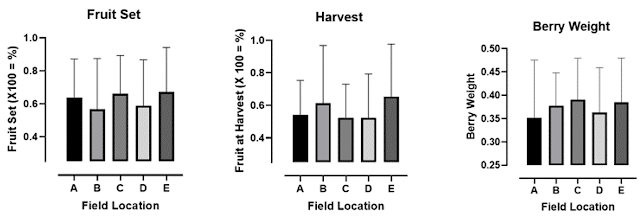This week, we will continue our discussion of wild blueberry pollination using honey bees. After stocking density, another consideration for wild blueberry producers is hive placement. It is important to have hives placed in an accessible location for beekeepers, and beyond that there are questions of spacing for maximum pollination. Today we will discuss hive placement on wild blueberry fields for optimal pollination services.
Hive Placement for Wild Blueberry Pollination
ATTTA began research in the 2021 field season to measure the
distance that honey bees will successfully pollinate blueberry blooms in proximity
to their hive. Our assessment included five points, the first of which was in
the blueberry field near the recently placed hives. From this point we continued across the field
in a “W” shaped pattern to cover approximately +150m across the breadth of the
field. At each of five field locations, we assessed 200 blueberry stems to
establish the percent fruit set, percent of harvestable berries, and the berry
weight over the course of three visits.
In the ten fields we visited in both Nova Scotia and New Brunswick, we found no statistically significant difference in percent fruit set, harvestable berries, nor berry weight based on the distance of the sample location from the hives. This suggests that at a minimum of 150m from their hives, honey bees will evenly pollinate all blooms. Given these results, wild blueberry flowers should be consistently pollinated across a field if hives are placed in 300m increments.
Published research papers have also demonstrated that distance is not a limiting factor in successful honey bee pollination on wild blueberry fields, within the range of study. A simulation comparing the pollination services of honey bees, bumble bees, and solitary bees on fields in Maine demonstrated that unlike bumble bees and solitary bees, the distance of a honey bee hive from blueberry blooms did not significantly effect fruit set (Qu and Drummond 2018). In the simulation, bumble bee and solitary bee populations both showed reduced pollination activity, measured by fruit set, as the insects had to travel further from their hives and nests to pollinate clones. Honey bee foraging behavior is thought to play a role in this observation. When a foraging honey bee finds a source of nectar or pollen, she will return to the hive to tell other foragers about this source. In what is called the waggle dance, individual bees are able to provide other foragers with directions to this desirable location. As such, far away forage can be revisited multiple times and a honey bee colony can efficiently explore a large area (Tereshko and Loengarov 2005).
Given that our results did not reach a limit of successful
pollination, it is possible that honey bees will pollinate wild blueberry
blooms beyond 150m from the hive. They can certainly be found at greater
distances from their hives. An early study of honey bee pollination on wild
blueberry fields in Quebec found that honey bee densities in a field did not
begin to significantly drop until the hives were beyond 3km from the location
in question (Aras, De Oliveira, and Savoie 1996). Before this point, honey bee
density was measured to be well over 10 per 2m2.
The results of our research and relevant publications suggests that honey bees are steady pollinators in wild blueberry fields. Our results reflect that hive placement every 300 meters should provide consistent pollination throughout a field. Stay tuned for more as we carry on with our pollination series in a discussion of hive strength for pollination in a subsequent blog.
Tereshko, Valery, and Andreas Loengarov. 2005. “Collective Decision-Making in Honey Bee Foraging Dynamics,” 8.
Connecting with ATTTA Specialists

